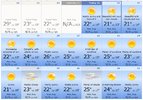Hexah, I'm sure you're on a wind-up. 1.8m dish 0.5º off axis has 42dBi gain at 11.7 GHz. 2.4m dish also has 42dBi gain at 0.5º off axis. But satellites at 28E don't wander around to that degree. If you point the dish at 28.35E you are always going to be within 0.25º of every satellite on the slot. Gain figures for 0.25º off axis are 46dBi for a 2.4m dish and 44dBi for a 1.8m dish. And things aren't even as bad as that because Eutelsat is FEC 2/3 and can still be easily received at 38dBi which corresponds to a 2.4m dish 0.7º off axis.
The last time there was a discussion of 0.2 degree spaced satellites among us owners of big dishes there was general agreement.
My experience over the decades is of very clear separate peaks using a 2m with the co-sited satellites. Anyone setting up a big dish will have noticed that. Although its possible that the error correction in digital masks that, it is unmistakable and entirely repeatable with analogue. Granularity is extremely fine with a locking bar, and too coarse with an actuator.
So to return to a first principles common sense description of the problem:
using a single dish when wanted channels are on two different though co-sited satellites with slightly different footprints with the classic fringe (out of intended service area) problem of radiated signal intensities which vary by transponder and varied mux transmission characteristics, means having to proritise dish focus on one set of channels and accept that the other set is going to be marginal and could break up at any time. Some unfortunate people are having to put up with the stronger set of channels being prone to break up at times and the weaker set of channels becoming unreliable and frequent break up of reception is something they have to put up with.
So at that point it is clear that using two big dishes is a possibility, each focused on the weakest of the channel in the sets required. As has been discussed before.
The scenario for most people in Spain is like this:
If I lived in Spain I would use a multiswitch system to have satellite in every room that needed it. IRS demands at least a dish size up anyway to ensure good CNR and MER, but even without a multiswitch based distribution system I always go up at least one dish size for a better margin (remember I could use a sly zone 1 mini dish here in the uk but I use an 80cm for better margin as per SES IRS recommendations). The aim is constant reception 24/7 without breakup regardless of the weather at ground level or in the atmosphere, so I don't get moaned at.
So then I would prepare for the worst case scenario which is a good margin for a multiswitch distribution system with long cables due to the dish being in the garden, in torrential rain with weak out of intended service area signals using FEC 9/10 (i.e. part of enforced marginality by a broadcaster).
Dish gain specifications are not really important. Link budget calculations are for served areas, not for the volatile conditions of fringe areas. This was established in the 1980s when fringe reception started. What is important is the margin. The bigger the dish the more margin you gain. We are talking about fringe reception, out of the intended service area, the signal weakened by beam shaping and intentional adverse transmission characteristics, where uncontrollable upper atmosphere thermal electrical activity and surface weather conditions have a disproportionate effect leading to sudden dramatic drops in signal, eroding the margin very rapidly.
So if I moved to a part of Spain where people moved from 1.2m to 1.5m I'd go straight to 2m because they aren't much more expensive than 1.8m but the margin and future proofing is so much better. If I moved to a part of Spain where people moved from 1.4m or 1.6m dishes to 1.8m then I would move straight to 2.3m or 2.4m. If I moved to a part of Spain where people moved from 2.3 or 2.4m, well I wouldn't move to that part of Spain because that is getting into the Cyprus nightmare situation of 3.8m! And look at reception in Cyprus now.
I note that the various people I have recommended to get dishes over the size commonly used in the areas of France or Spain they were in and occasionally recommended separate dishes over offset multi LNB rigs, and who I have given my view of the risks and benefits to, and who have taken my suggestions (and others), have never come back and complained about weather related reception problems despite some areas getting monsoon type rains at certain times of year.
When setting up a two dish system, the dish set on the western most satellite is put the the west of it and brought back slowly to peak, and the other dish would approach from the easterly satellite from the east. This is to try and get around the problem of digital error correction blunting the peaks. Its annoying because the digital signal is modulated on a wave of carrier energy which will have a pin prick peak of intensity (dialing in on the beacon may help, the problem is being able to resolve it).
continued in the next post




